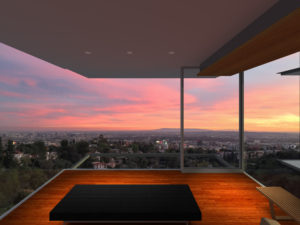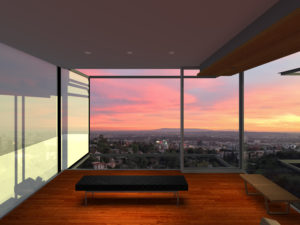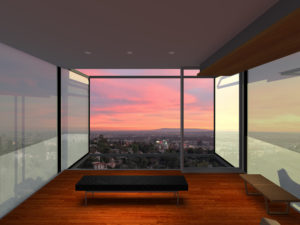I should say: the house shelters day-dreaming, the house protects the dreamer, the house allows one to dream in peace.
~ Gaston Bachelard, The Poetics of Space
PRIVACY / SHADING DEVICES
The DTS Project House design includes stone filled gabion walls that provide privacy and shade. The large areas of the glass boxes that escape the limits of the gabion walls call for a means of providing privacy and shading that contrasts with the heaviness of the fixed gabion walls in order to accentuate the experience of limits and liberation. This design intention leads to a light and mobile means of privacy and shading that responds to changing spatial use and climate conditions. The need for privacy changes as the use of the space changes and the exterior reflective conditions change as day turns into night. The need for shading changes as the climatic conditions and exposure change and as the sun rises and falls. Sometimes the requirements for privacy and climate control align, but often they are competing interests. Also, the privacy requirements required for the daytime and nighttime experience of the house sometimes align, but most often they are again competing interests. The success of the architecture in some part is dependent on resolution of these competing interests and how privacy and energy management interface.


Determining the best means to achieve privacy and shading requires the evaluation of multiple design aspects. Thus, a variety of means were evaluated to see how they achieve specific functional results and how they generally do or do not integrate with the architecture. mills studio visited, documented, and evaluated diverse ways to provide privacy and shading of expansive areas of glass. mills studio experienced buildings where the privacy / shading elements are an architectural feature, and where they are incidental to the architecture; buildings where the privacy and shading were achieved with a single design element, and buildings where privacy and shading are achieved by separate means; buildings where the method for privacy and or shading are the same on all exposures, and where the methods are exposure specific.
And when an architect has designed a house with large windows, which is a necessity today in order to pull daylight into these very deep houses, then curtains come to play a big role in architecture.
~ Arn JacobsenThe means for providing privacy and shading affect both the exterior and interior experience of the building with the material colors, textures, and design contributing greatly to the intended aesthetic. Often the means for achieving privacy and shading have a major impact on the interior design results, the least of which might be shadows cast by the screening devices dynamically animating the various surfaces. Material choices have many repercussions from the visual to the sensual to the tactile to the acoustical. To make material choices, the basic question of which side of the glass the privacy / shading elements are placed – are they interior or exterior – has to be answered. Other intentions that must be defined: if and how the elements do or do not direct the view from the interior, such as up or down (particularly important on a hillside); how the elements change the view into and out from the building relative to the viewers position, such as from below or in true elevation; are elements fixed or mobile; if mobile, how do mobile elements move, such as pivoting or stacking, and if stacking, how does the overlay of multiple layers alter the view into and out from the building; are the elements see-thru, opaque, or reflective (even mirrored) from the exterior, and how does this change from daytime to nighttime?
Mobile privacy and shade elements have the opportunity to contribute to a kinetic architecture adjusting itself to dynamically changing conditions. The decision on how to operate these mobile elements follows from attitudes about Maker Culture, how technology integrates into daily life, and energy management. Should energy management take precedence leading to the primacy of the digital world of programming and screens to make human interaction unnecessary to respond to ever changing conditions. Or does the tactile experience of architecture take precedence leading to an analog method of control relying on direct human interaction. Achieving the proper balance between software programming and direct human physical effort is necessary to make a house more than a “machine for living”.
Civilization is the progress toward a society of privacy. The savage’s whole existence is public, ruled by the laws of his tribe. Civilization is the process of setting man free from men.
~ Ayn Rand

